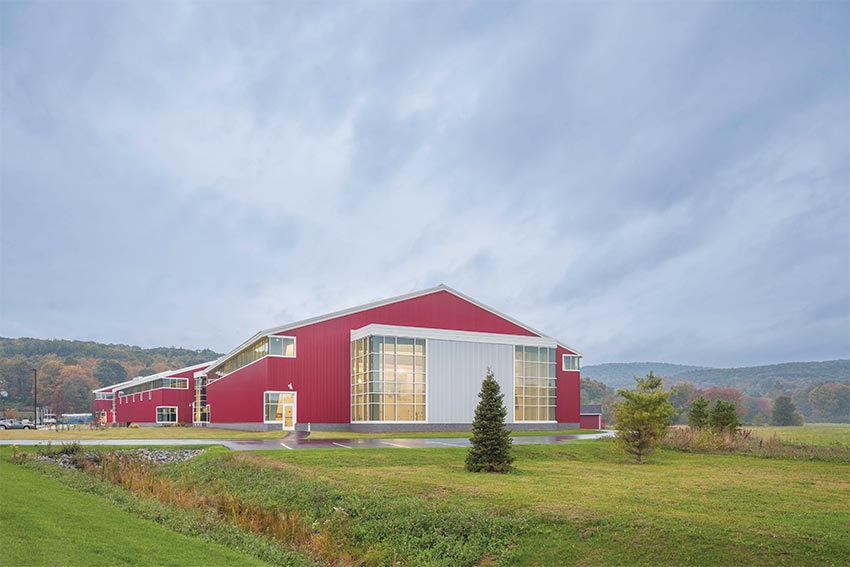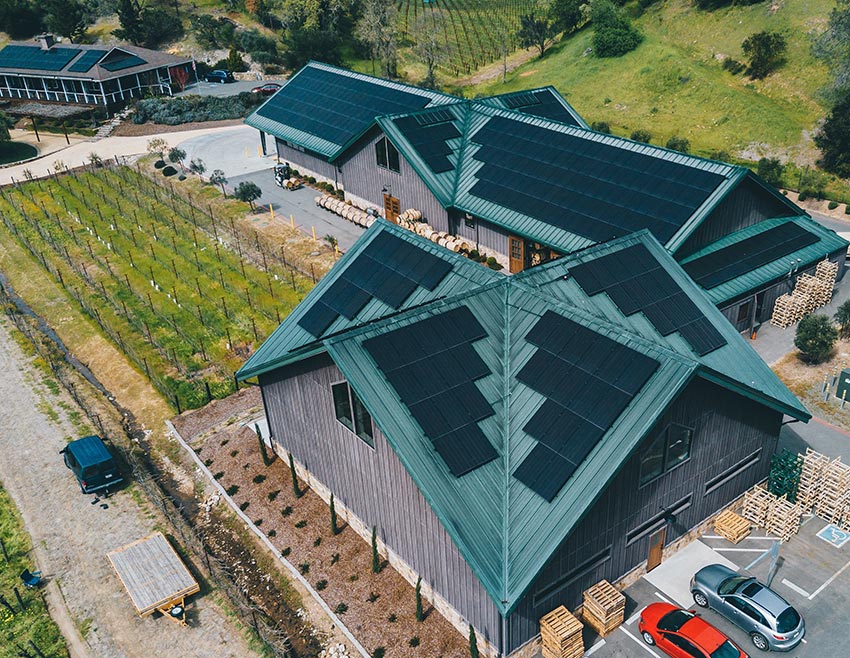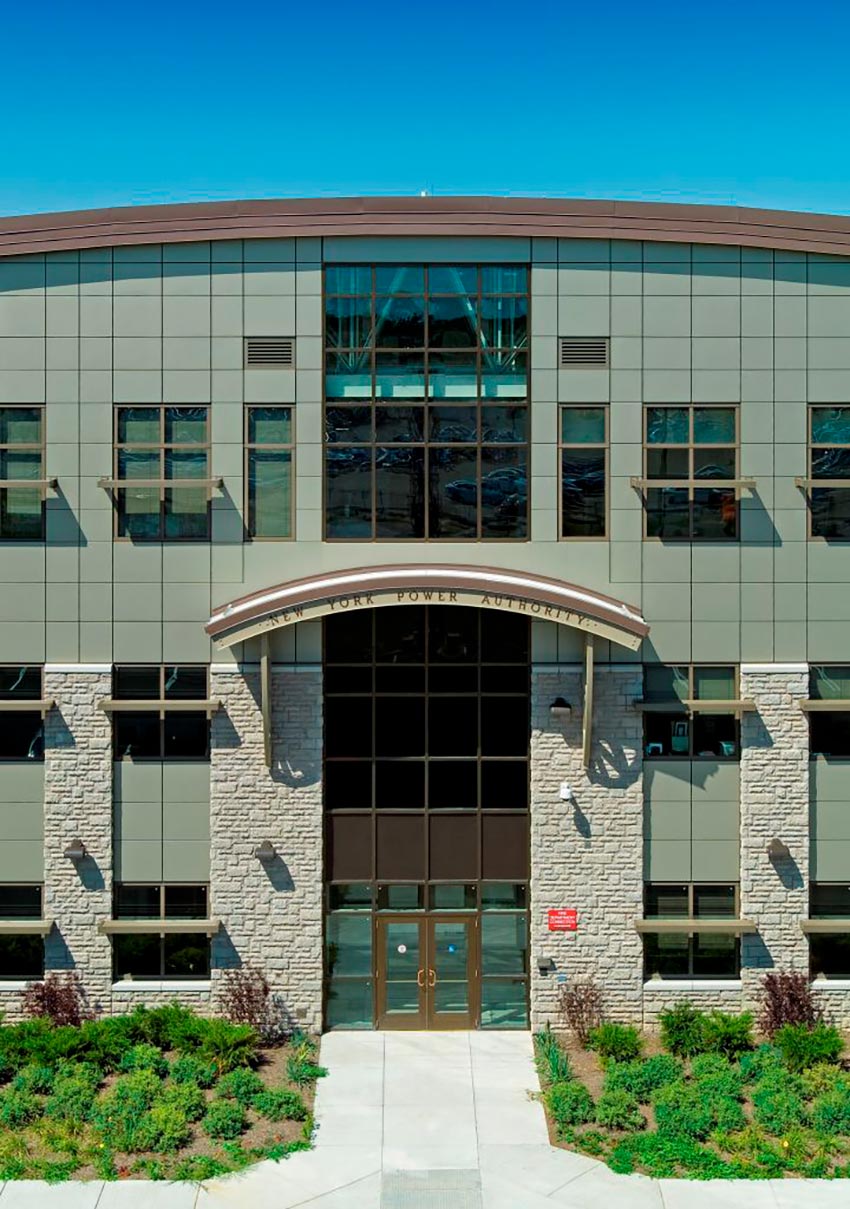To Code...and Beyond
IMPs are a type of “perfect wall,” due to the location of their control layers. Water, air, and vapor control layers are all located on the exterior of the structure, with thermal control located inboard structure along with duplicate air and vapor control layers. Because of this construction, IMPs can be used in all climate zones: cold, mixed, hot, humid, dry, or marine. IMPs also work for the demands of all interior environments: office, commercial, residential, institutional, pools, museums, art galleries, and data-processing centers.
IMPs can be used as a rainscreen barrier wall system and integrated with other wall and roof systems while still maintaining proper control-layer continuity.

Photo courtesy of Kingspan
Insulated metal panels (IMPs) offer a type of “perfect wall” in one component, controlling for rain, air, vapor, and thermal conditions, as shown here at the Keene Family YMCA in New Hampshire.
IMPs provide all four control layers within a single component, meaning they do not require the use of supplemental air/water/vapor or thermal control layers. Depending on climate zone and special requirements, IMPs can be used with supplemental cavity insulation subject to ratios listed in the IBC.
Guaranteeing Performance: General Codes and Properties of IMPs
Placing a product in a building means betting the future of the structure on that product’s performance. Three major standards apply to IMPs and are used to satisfy IBC Chapter 26 requirements:
- FM Approvals 4471 approval standard for roofs (fire and uplift);
- FM Approvals 4880 approval standard for walls and roofs (fire only); and
- FM Approvals 4881 approval standard for exterior walls (fire and structural).
Under Chapter 14, NFPA 285 Standard Fire Test Method for Evaluation of Fire Propagation Characteristics of Exterior Wall Assemblies Containing Combustible Components is critical for compliance.
When an IMP panel meets required certifications and codes, the entire assembly has been put to the test. Everything from the metal facings and metal gauge’s thickness and tensile and yield properties; to foam core properties, including cohesion (how well foam sticks to itself when pulled apart), compression (how well foam holds up under pressure), and adhesion (how well foam sticks to metal skins); to panel design (joint engagement, including male/female interlock depth and joint strength; geometry of male/female interlock, width of panels, including distance between side joints and thickness; and distance between skins); and finally, attachment methods (clip strength, clip fit and placement within joint, load-bearing area of clip, pullout strength of fasteners, pullout resistance of structural supports) is analyzed.
Engineering safety factors are determined by building codes, industry practices, general engineering principles, or ICC-ES Acceptance Criteria. For IMPs, overall panel strength is determined by the following laboratory tests:
- ASTM E72-10: Standard Test Methods of Conducting Strength Tests of Panels for Building Construction; and/or
- ASTM E330–E330M-14: Standard Test Method for Structural Performance of Exterior Windows, Doors, Skylights and Curtain Walls by Uniform Static Air Pressure Difference.
Insulating Capabilities of IMPs
Keeping the outside out and maintaining the comfort inside is one of the principle jobs of the building envelope. The ANSI/ASHRAE/IES Standard 90.1: Energy Standard for Buildings Except Low-Rise Residential Buildings shows a clear trend for continuous insulation, specifically in zones 5–8. Continuous insulation is the best method to improve thermal performance. Properly installed, it increases the effective R-value of the wall system. Continuous insulation blocks thermal bridging (heat transfer) created by common types of exterior wall construction.
The primary reason foam plastic insulation materials are extensively used in building construction is that they tend to provide a higher insulating value per inch than many other materials. IMPs generally use a foamed-in-place or polyisocyanurate foam plastic insulation, at thicknesses of 2–4 inches, achieving R-values in place of up to 45. This type of material can provide a thermal resistance value (R-value) of 7 per inch (nom.), compared to values of between 2 to 4 for fiberglass or mineral wool. High R-values are a driving reason behind the popularity of foam plastic insulation materials.

Photo courtesy of All Weather Insulated Panels
IMPs offer excellent insulating values and protect against thermal bridging losses, as shown here at the Verge Winery in California.
Additional insulation may be added to IMPs based upon a WUFI analysis, which evaluates the action of heat and moisture in walls, to meet other specified requirements. WUFI is a computer program that can tell how moisture and heat flow affect building materials over time. IMP systems, by virtue of their joint geometry, address thermal bridging in a more robust manner than typical site-built assemblies for walls and roofs, a design asset for maintaining thermal performance. Thermal bridging occurs when there is a break in a building’s insulation, so it is important to carefully consider the joint detailing when selecting a system.
Water- and Air-Barrier Capabilities of IMPs
The most important nonstructural and non-fire-performance aspect of any wall system is its ability to control rainwater, according to Lstiburek. Historically, the most widely used method of controlling rainwater is by installing claddings over IMP systems, providing a continuous water control layer coupled with a continuous drained air gap over this water control layer. Because of this history of past performance in application, IMPs are widely recognized for their water- and air-barrier capabilities.
Two major ASTM standards are used to evaluate air and water performance of IMP wall assemblies: ASTM E283-04 (2012): Standard Test Method for Determining Rate of Air Leakage Through Exterior Windows, Curtain Walls, and Doors Under Specified Pressure Differences Across the Specimen and ASTM E331-00 (2009): Standard Test Method for Water Penetration of Exterior Windows, Skylights, Doors, and Curtain Walls by Uniform Static Air Pressure Difference.
Roof assemblies are evaluated by their own ASTM standards for air and water performance: ASTM E1680-11: Standard Test Method for Rate of Air Leakage Through Exterior Metal Roof Panel Systems (Specialized adaptation of E283) and ASTM E1646-95 (2011): Standard Test Method for Water Penetration of Exterior Metal Roof Panel Systems by Uniform Static Air Pressure Difference (specialized adaptation of E331). To best leverage the insulating and water- and air-barrier capabilities of IMP systems, it is important to pay close attention to how the system interfaces holistically. Paul Collyer, vice president of business development for Cornerstone Building Brands in Denver, emphasizes that when dealing with any type of barrier wall, it is important to maintain continuity of control layers—specifically air, vapor, water, and thermal. “Proper details showing how the barrier system should interface with penetrations, material transitions, etc. are critical to proper envelope performance,” he says.










